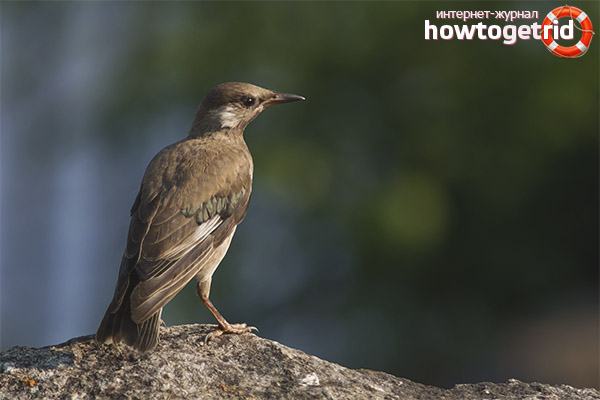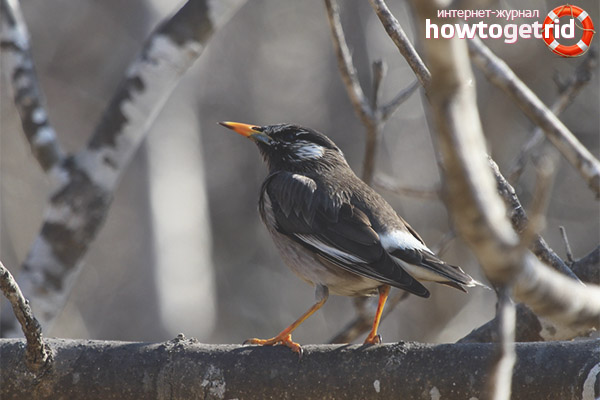The content of the article
Starling is a passerine bird; it can beautifully sing, intermix and destroy harmful insects, for which he is loved by man. There are about a dozen species of this bird living on the mainland of Eurasia, one of them is a gray starling.
Description
The gray starling is no larger than a thrush, length is 20-25 centimeters. On top it has feathers of brown or smoky color, chest, nadhvoste and tummy slightly lighter - light gray or dirty white. The feather cover on the head is either completely white with a large number of black spots, or black-brown with white spots. But in both cases beams of white feathers stand out on the cheeks. Eyes usually brown. The beak is yellow with splashes of orange, the tip is dark. The tail is brown, an average of 6.5 centimeters long, the legs are similar in color to the beak - yellow with orange. Females differ slightly in color - slightly lighter than males.Starlings of all breeds have the same voice - sharp crackling and clicking.
Habitat
It is distributed in the territories of Japan, Korea, nests in Northeast China, Mongolia, feels at ease throughout the East Asian territory. In Russia, it is found mainly in the eastern territories - in the south of the Transbaikalia and Pribaikalye, in Primorye, on the southern extremities of the Kuriles and the Sakhalin Peninsula. For living and nesting it prefers flat woodless terrain - urban gardens and parks, small groves, rare forest, pastures. A forest with dense and abundant vegetation does not seduce it.
Lifestyle
They fly in the same large flocks, managing to soar, rotate, and land at the same time - a clear and strict organization is felt.
The gray starling is not a very good neighbor: for a profitable area in which you can nest and live, he will fight with any birds.
Wintering
All gray starlings, except those living in Japan, go for the winter to warm regions, overcoming several thousand kilometers - fly to the north of Africa, to warm regions of India, and so on. As a rule, flights begin with the onset of frost - from September to early November. Young animals without nests fly away in the summer.
Nutrition

In the diet, the gray starling does not limit itself to anything — consumes both animal food and vegetable food. Although prefers, of course, more living organisms. It feeds away from the nest, eats all sorts of insects: beetles, bears, ants and others. Also eagerly hunts and eats their larvae. It hunts crayfish, shrimps, frogs, newts, lizards. From vegetarian food, cherries, berries of various plants, fruits growing on trees, seeds of wild and cultivated cereals, and vegetables are included in the diet.
Breeding
Since wintering, the males arrive first and begin to bother about finding places to live.In addition to huddled up specifically for starlings of birdhouses, these birds like to settle in attics and under the roofs of some buildings, in holes in the wall, hollows. Having picked up a place for nesting, they spread it from the inside with torn off thickets of last year’s grass, either with their own or other feathers.
Eggs are laid twice per season - the first time in late April or early May. From 2 to 10 eggs of blue color are laid and they hatch about two weeks - 12-14 days. Both parents engage in incubation, although the male is often absent in search of food.
Nestlings are born completely naked, not dependent, the first days only the male feeds, constantly bringing in more and more new portions of food. In the first days, soft food is brought in, the harder (locusts, grasshoppers, snails, and so on) the male pulls up later - when the brood grows up, and the mother warms the babies with warmth. During this time, replenishment in the starling family can be recognized only from the remnants of the shell that fell on the ground - the chicks behave so quietly. After 21-24 days, they grow up, stand on the wing and begin an independent life.
Interesting
- The life span of a gray starling in nature was documented and confirmed - it is about 12 years, and in captivity it reaches 20.
- Starlings are great imitators. And the gray starling is no exception. Usually, the surrounding sounds are imitated - singing of Russian and subtropical birds, dog barking, cats meowing, cows bellowing, creaking well gates and opening gates, the roar of the engine of an approaching car, and so on. The more years a singer, the richer his repertoire.
- Despite the fact that the starlings benefit the person by destroying insect pests, there is also enough harm from these birds - so, having gotten into the taste and carried away by catching prey, they can destroy crops, vineyards, by eating grains and berries. For example, Australians have even created a special service for starling hunters.
- Making flights, the birds overcome in one day about 90 kilometers, making 3-4 stops during the day.
- The resulting huge flock of starlings is impressive, but some Europeans are very negative about this. For example, the Romans try not to leave the house. Avian din and chirping can be heard for many kilometers and often even covers the noise of vehicles and vehicles.
- Tamed very easily. To do this, it is enough from time to time to feed the starling and after a short time he will start to sit on his hand and take crumbs or offered bugs.
- If the male after arrival from wintering could not find a pair, he lives alone until the next spring.












To send